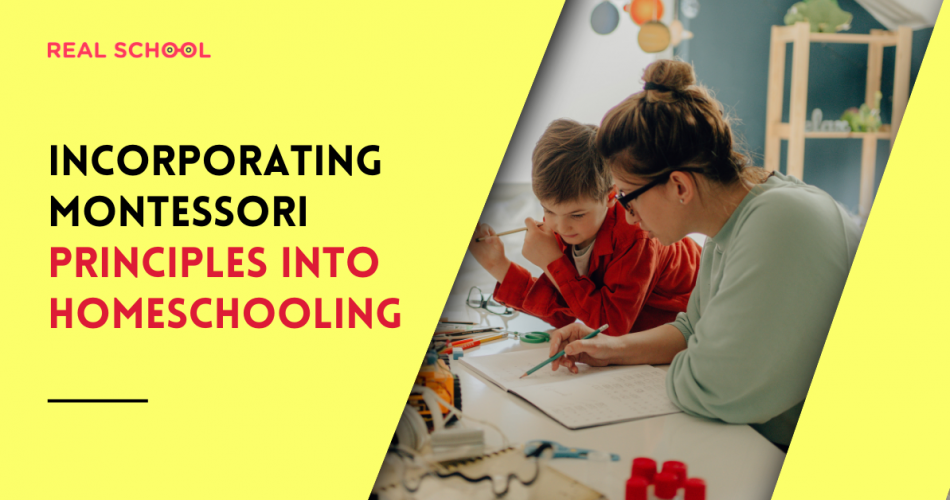Montessori principles offer a rich and effective educational approach that can be seamlessly integrated into homeschooling. Dr. Maria Montessori’s philosophy emphasizes hands-on learning, independence, and child-led exploration, making it well-suited for a homeschool environment. In this article, we will explore practical ways to incorporate Montessori principles into homeschooling and create a nurturing and enriching learning experience for your child.
-
Prepare a Child-Centered Learning Environment
Just like in a Montessori classroom, setting up a child-centered learning environment at home is crucial. Designate specific areas for different learning activities, such as a reading nook, an art station, and a science corner. Organize materials on accessible shelves, allowing your child to independently choose and engage with activities that pique their interests.
-
Follow Your Child’s Lead
Montessori education is all about following the child’s lead. Observe your child’s interests, strengths, and challenges, and adapt the curriculum accordingly. Allow your child to have a say in their learning journey, giving them a sense of ownership and motivation to explore topics that fascinate them.
-
Utilize Montessori Materials
Incorporate Montessori materials into your homeschooling environment. Many Montessori-inspired materials can be easily made or purchased online. Materials like the Movable Alphabet, Sensorial materials, and Mathematics manipulatives provide concrete learning experiences that foster understanding and curiosity.
-
Encourage Practical Life Activities
Practical life activities are a fundamental aspect of Montessori education. Integrate practical life skills into your homeschool routine. Involve your child in everyday activities like cooking, cleaning, and gardening. These activities not only promote life skills but also support the development of fine and gross motor skills.
-
Emphasize Hands-On Learning
Montessori principles advocate for hands-on learning experiences. Incorporate experiments, projects, and field trips into your homeschool curriculum. Engaging in hands-on activities allows children to make meaningful connections between theoretical concepts and real-life experiences.
-
Foster Independence and Self-Directed Learning
Encourage independence in your homeschooling routine. Teach your child to manage their time and take responsibility for their learning. Offer choices and options, allowing your child to select activities and projects that resonate with them. Self-directed learning builds self-confidence and a love for exploration.
-
Embrace the Joy of Learning
Montessori education celebrates the joy of learning. Create a positive and encouraging learning environment at home. Celebrate your child’s progress and efforts, rather than focusing solely on outcomes. Nurturing a love for learning will foster a lifelong curiosity and thirst for knowledge.
-
Encourage Multi-Age Learning
Montessori classrooms often have mixed-age groups, promoting collaboration and mentorship among students. In a homeschool setting, if you have multiple children, embrace multi-age learning opportunities. Older siblings can assist and mentor younger ones, fostering a supportive and cooperative learning environment.
-
Provide Uninterrupted Work Time
Dedicate uninterrupted work periods for your child to explore and engage in activities of their choosing. During these periods, minimize distractions and provide focused attention to support your child’s concentration and deep engagement in their learning.
-
Foster a Connection with Nature
Incorporate nature into your homeschooling experience. Spend time outdoors, engage in nature walks, and incorporate nature-based learning activities. Nature provides a stimulating and calming environment for children to explore and connect with the natural world.
Conclusion
Incorporating Montessori principles into homeschooling creates a personalized and child-centered educational experience. By following your child’s lead, providing hands-on learning opportunities, and fostering independence, you empower your child to become a self-motivated and enthusiastic learner. Embrace the flexibility and creativity that homeschooling allows, and let the Montessori philosophy guide your homeschooling journey, nurturing your child’s curiosity, independence, and love for learning.
FAQs (Frequently Asked Questions)
Can Montessori principles be adapted for homeschooling children of different age groups?
How can I create a child-centered learning environment at home for homeschooling?
Are there resources or curricula available that align with Montessori principles for homeschooling?
How do I support my child’s social development in a homeschooling setting?
What are some examples of hands-on learning activities that can be incorporated into homeschooling?







